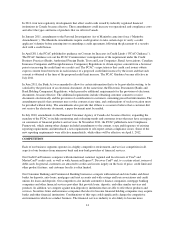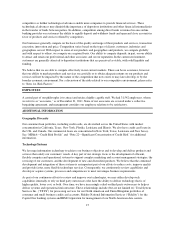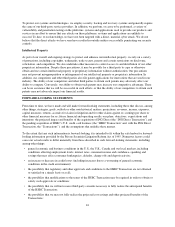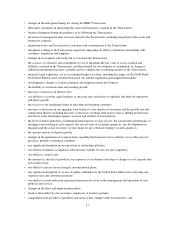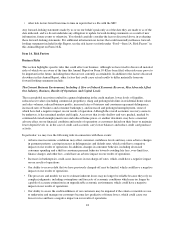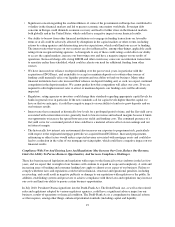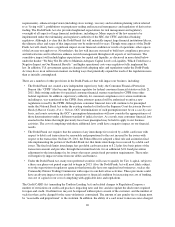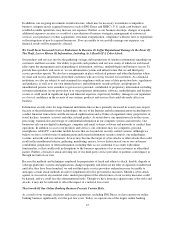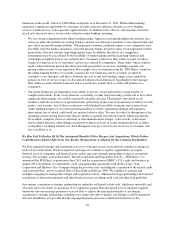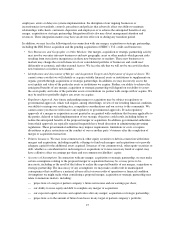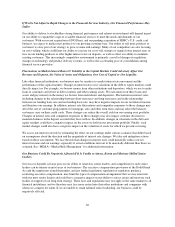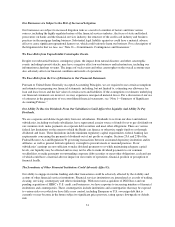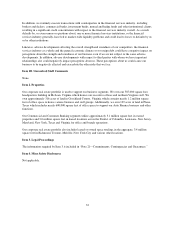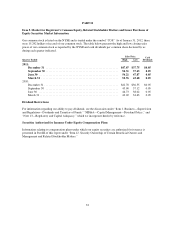Capital One 2011 Annual Report Download - page 43
Download and view the complete annual report
Please find page 43 of the 2011 Capital One annual report below. You can navigate through the pages in the report by either clicking on the pages listed below, or by using the keyword search tool below to find specific information within the annual report.We May Not Be Able to Maintain Adequate Capital Levels or Liquidity, Which Could Have a Negative Impact
on Our Financial Results.
As a result of the Dodd-Frank Act and international accords, financial institutions will become subject to new
and increased capital and liquidity requirements. Although it is not yet clear what form these requirements will
take or how they will apply to us, it is possible that we could be required to increase our capital levels above the
levels in our current financial plans. These new requirements could have a negative impact on our ability to lend,
grow deposit balances or make acquisitions and on our ability to make capital distributions in the form of
increased dividends or share repurchases. Higher capital levels could also lower our return on equity.
Recent developments in capital and liquidity requirements that may impact us include the following:
• In December 2010, the Basel Committee on Banking Supervision published a final framework (commonly
known as Basel III) on capital and liquidity. The key elements of the capital proposal include: raising the
quality, consistency and transparency of the capital base; strengthening the risk coverage of the capital
framework; introducing a leverage ratio that is different from the U.S. leverage ratio measures; promoting
the build-up of capital buffers; and imposing a capital surcharge for global systemically important
institutions. The liquidity framework includes two standards for liquidity risk supervision, one standard
promoting short-term resilience and the other promoting longer-term resilience. How U.S. banking
regulations will be modified to reflect these international standards remains unclear, particularly given the
forthcoming capital and other prudential requirement regulations under the Dodd-Frank Act and the current
Prompt Corrective Action framework. We expect, however, that minimum capital and liquidity
requirements for us and other institutions will increase as a result of Basel III, the Dodd-Frank Act and
related activity.
• In November 2011, the Federal Reserve finalized capital planning rules applicable to large bank holding
companies like us (commonly referred to as Comprehensive Capital Analysis and Review or CCAR). Under
the rules, bank holding companies with consolidated assets of $50 billion or more must submit capital plans
to the Federal Reserve on an annual basis and must obtain approval from the Federal Reserve before making
most capital distributions. The purpose of the rules is to ensure that large bank holding companies have
robust, forward-looking capital planning processes that account for their unique risks and capital needs to
continue operations through times of economic and financial stress. As part of its evaluation of a capital
plan, the Federal Reserve will consider the comprehensiveness of the plan, the reasonableness of
assumptions and analysis and methodologies used to assess capital adequacy and the ability of the bank
holding company to maintain capital above each minimum regulatory capital ratio and above a Tier 1
common ratio of 5% on a pro forma basis under expected and stressful conditions throughout a planning
horizon of at least nine quarters.
• Because we are a consolidated bank holding company with consolidated assets of $50 billion or greater, we
are subject to certain heightened prudential standards under the Dodd-Frank Act, including requirements
that may be recommended by the Financial Stability Oversight Council and implemented by the Federal
Reserve. As a result, we expect to be subject to more stringent standards and requirements than those
applicable for smaller institutions, including risk-based capital requirements, leverage limits and liquidity
requirements. In December 2011, the Federal Reserve released proposed rules beginning to implement the
enhanced prudential requirements, including a detailed liquidity framework. If finalized as proposed, these
requirements would increase our liquidity requirements and associated compliance and operational costs.
• The Basel II final rules as implemented in the United States are mandatory for those institutions with
consolidated total assets of $250 billion or more or consolidated total on-balance-sheet foreign exposure of
$10 billion or more. We expect to become subject to these rules at the end of 2012 as a result of the
acquisition of ING Direct. Prior to full implementation of the Basel II framework, organizations must
complete a qualification period of four consecutive quarters, known as the parallel run, during which they
must meet the requirements of the rule to the satisfaction of their primary U.S. banking regulator. Based on
current growth estimates, we would expect to enter parallel run January 1, 2015. This will require
23



